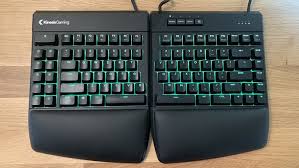Article Outline: Comfort Typing: Exploring Ergonomic Keyboards for All Users
Introduction
- Hook: Highlight the importance of comfort and ergonomics in typing, especially for prolonged computer use.
- Significance: Discuss the impact of ergonomic keyboards on reducing strain, discomfort, and potential injuries.
- Overview: Provide a brief overview of the guide’s exploration into ergonomic keyboards and their benefits for all users.

Section 1: Understanding Ergonomic Keyboards
- Introduction to Ergonomic Keyboards: Define what ergonomic keyboards are and how they differ from standard keyboards.
- Benefits of Ergonomic Design: Explore the advantages of ergonomic design in keyboards, including improved comfort, reduced strain, and enhanced productivity.
- Key Features of Ergonomic Keyboards: Discuss common features found in ergonomic keyboards, such as split layouts, curved designs, adjustable tenting, and wrist rests.
Hey there! Let’s kick things off by diving into the wonderful world of ergonomic keyboards. Don’t worry if you’re not familiar with the term – we’ll break it down for you.
Introduction to Ergonomic Keyboards: So, what exactly are ergonomic keyboards? Well, they’re not your everyday keyboards that you find in offices or schools. Ergonomic keyboards are specially designed to promote a more natural and comfortable typing experience. They’re all about reducing strain and discomfort, especially during those long hours of typing away at your computer.
Benefits of Ergonomic Design: Now, you might be wondering, why bother with an ergonomic keyboard? Trust me, there are plenty of good reasons. Ergonomic keyboards are designed with your comfort in mind, which means they can help reduce wrist strain, alleviate muscle tension, and even prevent long-term injuries like carpal tunnel syndrome. Plus, they can improve your overall typing speed and accuracy – who doesn’t want that?
Key Features of Ergonomic Keyboards: Okay, let’s get into the nitty-gritty. What sets ergonomic keyboards apart from the rest? Well, they come with a bunch of cool features that make typing a breeze. Think split layouts that let you position your hands in a more natural way, curved designs that mimic the shape of your hands, and adjustable tenting that allows you to customize the angle of your keyboard for maximum comfort. Oh, and don’t forget about those comfy wrist rests – they’re a game-changer!
By understanding the basics of ergonomic keyboards, you’ll be well on your way to typing bliss. So, get ready to say goodbye to wrist pain and hello to a more comfortable typing experience!
Section 2: Types of Ergonomic Keyboards
- Split Keyboards: Explore split keyboards, which separate the keys into two or more sections to promote a more natural hand position and reduce strain on the wrists and arms.
- Curved Keyboards: Discuss curved keyboards, which have a curved or contoured shape to better fit the natural curve of the hands and reduce wrist extension.
- Adjustable Keyboards: Highlight adjustable keyboards, which allow users to customize the keyboard’s angle, tilt, and height to find the most comfortable and ergonomic position.
- Compact Ergonomic Keyboards: Explore compact ergonomic keyboards, which offer ergonomic benefits in a smaller form factor suitable for limited desk space or portable use.
Alright, let’s take a closer look at the different types of ergonomic keyboards out there. From split keyboards to curved ones, there’s something for everyone. Let’s dive in:
Split Keyboards: Picture this – instead of having all your keys crammed together in one big block, split keyboards separate them into two or more sections. This design allows you to position your hands in a more natural way, reducing strain on your wrists and arms. Plus, it can help improve your typing posture and overall comfort.
Curved Keyboards: Now, if you’re looking for something a bit more stylish, curved keyboards might be right up your alley. These keyboards have a curved or contoured shape that mimics the natural curve of your hands. Not only does this make typing more comfortable, but it also reduces wrist extension – a win-win!
Adjustable Keyboards: One size doesn’t fit all when it comes to ergonomic keyboards. That’s where adjustable keyboards come in. These keyboards allow you to customize the angle, tilt, and height of your keyboard to find the perfect position for your hands. Whether you prefer a flat typing surface or a more raised one, adjustable keyboards have you covered.
Compact Ergonomic Keyboards: Short on desk space? No problem. Compact ergonomic keyboards offer all the ergonomic benefits of their larger counterparts in a smaller form factor. Perfect for those with limited space or anyone who likes to take their ergonomic setup on the go.
With so many options to choose from, finding the perfect ergonomic keyboard is easier than ever. So, whether you’re a split keyboard fanatic or a curved keyboard connoisseur, there’s an ergonomic keyboard out there that’s perfect for you.
Section 3: Choosing the Right Ergonomic Keyboard
- Assessing Individual Needs: Encourage readers to assess their typing habits, ergonomic preferences, and any existing discomfort or strain to determine the most suitable ergonomic keyboard for their needs.
- Testing Keyboards: Recommend testing out different ergonomic keyboards in person or purchasing from retailers with generous return policies to ensure compatibility and comfort.
- Considering Budget and Features: Discuss factors like budget, additional features (e.g., wireless connectivity, customizable keys), and warranty coverage when choosing an ergonomic keyboard.
- Reading Reviews and Comparisons: Advise readers to research and read reviews and comparisons from reputable sources to make informed decisions about ergonomic keyboards.
Now that you know the ins and outs of ergonomic keyboards, it’s time to find the perfect one for you. With so many options on the market, it can feel a bit overwhelming, but fear not! Here’s how to narrow down your choices and pick the ergonomic keyboard of your dreams:
Assessing Individual Needs: First things first, take a moment to think about your own typing habits and preferences. Do you spend hours typing away at your computer, or do you only use it occasionally? Are you prone to wrist pain or discomfort? Understanding your needs and any existing discomfort will help guide your decision-making process.
Testing Keyboards: If possible, try out different ergonomic keyboards in person. Get a feel for how they fit your hands and how comfortable they are to type on. Pay attention to factors like key spacing, key travel, and wrist support to determine which keyboard feels best for you. And don’t be afraid to ask questions – knowledgeable sales associates can help steer you in the right direction.
Considering Budget and Features: Next, consider your budget and what features are important to you. Do you want a keyboard with customizable keys or RGB lighting? Are you willing to splurge for premium materials and build quality? Think about what matters most to you and prioritize accordingly.
Reading Reviews and Comparisons: Finally, do your research. Read reviews and comparisons from reputable sources to get a sense of what other users have experienced with different ergonomic keyboards. Look for keyboards with positive reviews and a track record of satisfied customers.
By following these tips, you can find the perfect ergonomic keyboard to suit your needs and typing preferences. So go ahead, explore your options, and get ready to type in comfort and style!
Section 4: Maintenance and Care Tips
- Cleaning and Maintenance: Provide tips for cleaning and maintaining ergonomic keyboards to prolong their lifespan and performance, including removing dust and debris, cleaning keycaps, and protecting against spills.
- Software Updates and Firmware: Highlight the importance of keeping ergonomic keyboard software and firmware up to date to ensure compatibility, stability, and access to new features.
- Troubleshooting Common Issues: Offer troubleshooting tips for common ergonomic keyboard issues, such as connectivity problems, key sticking, and software glitches.
Now that you’ve got your hands on the perfect ergonomic keyboard, it’s important to keep it in tip-top shape. After all, a well-maintained keyboard can last you for years to come. Here are some maintenance and care tips to ensure your ergonomic keyboard stays comfortable and functional:
Cleaning and Maintenance: Let’s start with the basics – cleaning. Over time, dust, crumbs, and other debris can accumulate between the keys and underneath the keycaps, affecting performance and hygiene. Regular cleaning is key to keeping your keyboard looking and feeling its best. Use a can of compressed air or a soft brush to remove any debris from between the keys, and wipe down the keycaps and keyboard frame with a damp cloth or alcohol wipe to keep them clean and germ-free.
Software Updates and Firmware: Next up, don’t forget about software updates and firmware. Keeping your keyboard’s software and firmware up to date is crucial to ensuring compatibility, stability, and access to new features. Check for updates regularly and install them as soon as they become available to keep your keyboard running smoothly.
Protecting Against Spills: Accidents happen, especially when you’re typing away at your computer. To protect your keyboard against spills, consider investing in a spill-resistant keyboard cover or using a spill-proof keyboard. If you do happen to spill something on your keyboard, act quickly – unplug the keyboard, blot up any excess liquid, and let it dry completely before using it again.
By following these maintenance and care tips, you can ensure that your ergonomic keyboard stays comfortable and functional for years to come. So go ahead, show your keyboard some love, and enjoy typing in comfort and style!
Conclusion
- Summary: Recap key takeaways from the guide, emphasizing the benefits of ergonomic keyboards for comfortable typing and improved productivity.
- Encouragement: Encourage readers to explore the world of ergonomic keyboards and find the perfect one to suit their ergonomic needs and typing preferences.
- Closing Statement: Reinforce the importance of prioritizing comfort and ergonomics in typing to prevent strain and discomfort and promote long-term health and well-being.

